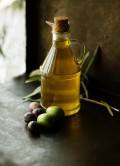Why You Need to Add Fat to Your Diet

I started drinking low fat milk, eating low fat yogurt and cheese. And then, all of a sudden, there were tons of low fat products and 100-calorie snack packs.
What??? You mean I can eat (low fat) cookies AND lose weight? YAAAS! Sign me up!
This was it. This was THE KEY to losing weight. Just don’t eat fat. Easy!
Talk about the science community getting something so very, very wrong…
Fat isn’t the culprit.
Fat isn't the reason why I was gaining weight.
Fat is, in fact, good for you.
Even saturated fats aren’t quite the demon anymore either. (I remember years ago, somebody arguing on some online forum that saturated fat wasn’t as bad for you as it was made out. So many people shouted him down. Turns out, he was way ahead of his time.)
Are You Afraid of Adding Fat Into Your Diet?
Not long ago, I realized something that kind of blew my mind: I was still afraid of fat in my diet.While I knew all the benefits and that fat is a necessary part of the diet, there was still a part of me that was holding back.
That comes from the years and years of eating low fat and being told how fat was SO bad for us. It was ingrained.
It took trying more of a high fat / low carb approach -- and seeing the results -- to convince me. And it’s been amazing! When I eat a breakfast that has a high amount of fat in it, plus protein and lots of veggies, I’m usually only hungry again around lunchtime. Thereby eliminating any mid-morning snacks. Which means I’m eating fewer calories. And that means fat loss.
See: Three Must-Eat Breakfast Foods To Help With Carb Cravings
I now eat butter, bacon, make fat bombs and an incredible high fat / low carb granola to help me LOSE weight.
No more low-fat snacks for me, ever again.
See: Making Weight Loss Simple Again
Why Your Body Needs Fat
Not only does fat provide energy for your body, it also helps with vitamin absorption, nerve transmission, immunity system support and hormone production. Even our brain is fat-based.A diet that is low in fat can cause vitamin deficiencies (vitamins A, D, E, and Ks are fat soluble). And a lack of those vitamins can affect all other parts of your body. A low-fat diet can even affect your mental state, including depression. A high fat diet can actually help with serious brain conditions such as epilepsy.
And another thing fat does which helps with weight loss: it helps you feel full longer. It takes longer to digest than carbohydrates. It’s one important reason why I suggest a high fat / low carb approach for most people when you’re first starting to lose weight.
The Different Kinds of Fat -- And One to Avoid
We’re not going to take a deep dive into the different kinds of fat. When saturated fat was demonized, it was important to know the differences between saturated and unsaturated fats. Now? Not so much. It's enough to know the basics.Saturated fats are usually solid or semi-solid at room temperature. Unsaturated fats -- monounsaturated and polyunsaturated -- are usually liquid at room temperature
It’s much more important to look for natural sources of fat from whole foods, aiming for a mix of ⅓ saturated, ⅓ monounsaturated and ⅓ polyunsaturated.
Avoid foods with trans fat and “processed” fats, such as hydrogenated oils. Check your food labels for a list of ingredients. Thankfully, fewer foods are being made with this trans fats. Basically, stay away from processed, packaged foods.
Eating a variety of full fat foods will help to ensure you get all kinds of fats into your body.
Healthy Fats to Add Into Your Diet
It's easy to add more fat into your diet.- You can start by going for full-fat dairy products (if you eat dairy).
- You can add butter or mayo to sandwiches (not huge glops of it! See serving sizes down below.).
- Drizzle oils and add nuts or seeds to your salad.
- Add nuts to your stir-fry.
- Add ground flax seed to your smoothies.
- Froth a dollop of coconut oil into your morning coffee.
- And please let's toss out those 100-calorie snack packs. They're usually just full of sugar.
Here’s a partial list of fats to add to your diet. Get creative!
- Avocado
- Avocado Oil Mayonnaise
- Olives
- Coconut Oil
- MCT Oil
- Coconut
- Coconut Milk (full fat, canned)
- Oils (avocado, olive, sesame, etc.)
- Almonds
- Brazil Nuts
- Macadamia Nuts
- Walnuts
- Seeds (sunflower, pumpkin, sesame etc.)
- Nut or Seed Butters
- Chia Seeds
- Flax Seeds
- Hemp seeds (hemp hearts)
- Butter
- Ghee
- Heavy Cream
- Egg Yolks
- Bacon
- Fattier Cuts Of Meat
- Dark Chocolate (90%+)
Serving Size of Fat - How Much Fat Should You Be Eating
Calorie-wise, one gram of fat clocks in at 9 calories per gram. That’s why it was given such a bad rap back in the low-fat days. The thinking was, if you cut down on fat, it would cut down on calories.Sure, technically, you’re eating few calories when you eat less fat. And that's what you need to do to lose weight: create a calorie deficit. But then you’d be hungry and get cravings, and end up eating even MORE calories.
See: Blood Sugar Roller Coaster
A serving size of fat is about 1 tablespoon or 1 thumb, if you’re doing hand-size portions.
See: How to Use Hand-Size Portions to Lose Weight
If you’re eating nuts and seeds, a serving size is generally about 1 ounce. I’ll usually count out about 10 almonds as a serving size for a snack. But what I like to do is add a few nuts in salads or in a stir-fry. Or I add seeds, like chia seeds, ground flax seeds or hulled hemp seeds, to a smoothie. And sometimes all three!
As an aside: fat is something most people forget to add into their smoothie. Then, they wonder why they’re so hungry after eating something “healthy” like a smoothie. You have to add fat. I go into that much more in my Soup, Salad Smoothie Program.
Aim for anywhere from 30% to 60% of your calories coming from fat in your diet. Yup, I said 60%. Crazy, right? That still triggers my "must eat low fat" gene. But you know what, I feel much better when I eat a diet higher in fat, and lower in processed carbs. I still eat carbs! But I get the majority of my carbs from vegetables and fruit.
But If I Add Fat To My Diet Won’t I Be Eating More Calories?
Yes, that’s true. If you simple add fat to your diet without making any other adjustments, then you run the risk of eating more calories than your body needs. That will cause weight gain. Absolutely!The solution is to that problem is to limit processed foods, especially processed carbs. Foods like bread, cookies, chips, pasta, crackers, granola bars, cereals, rice and potatoes.
Now, please don’t misunderstand me and think these foods are “bad”. I try to avoid saying foods are “bad” -- well, except for trans fat. That really is bad for you.
When I say “limit” for some of these foods, like rice or potatoes, what I really mean is: eat a proper serving size. Way too often we make these foods the star of the show. When we focus on eating fat, protein and veggies at every meal, with occasional processed carbs, that’s when we’re eating nutritious foods to help keep our blood sugar from spiking, avoiding crazy carb cravings.
And when you eat nutritious foods in the right amount for your body to lose weight, that’s when fat loss occurs.
As with anything you eat, don’t over do it. In my experience, hand-size portions are the way to go when it comes to knowing how much to eat to lose weight. How to add fat to your diet is one of the healthy habits I help my weight clients with in my 12 month program.
References:
https://www.precisionnutrition.com/all-about-healthy-fats
https://www.livescience.com/52851-low-fat-diet-facts.html
https://medlineplus.gov/ency/patientinstructions/000785.htm
